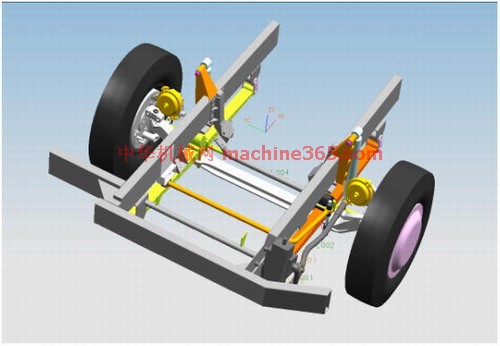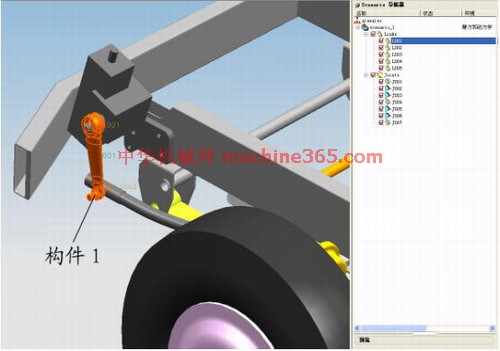1) Steering characteristics


转向特性
1.
The vehicle s steering characteristics of steady-and transient state under different operating mode can be evaluated by numerical integral making use of these nonlinear tire models to establish the vehicle dynamics equations.
利用这些非线性轮胎模型建立汽车动力学的非线性常微分方程组,通过数值积分,可以获得汽车在各种工况条件下的稳态与瞬态转向特性。
2.
The oversteering trend of a pre-research vehicle was forecasted using virtual simulation,then factors affecting the vehicle steering characteristics was discussed based on the study of wheel load change,aiming at this program,a method of thickening the anti-roll bar to make the vehicle have understeering performance was advanced.
借助虚拟样机仿真技术,发现某预研项目车辆具有过多转向趋势,在全面分析车轴左右轮荷变化的基础上,深入探讨了车辆转向特性的影响因素,针对本项目提出可通过加粗前悬架横向稳定杆直径的办法来获得车辆的不足转向特性。
3.
The factors influencing steering characteristics of multi-axle steering vehicle are analyzed.
探讨了采用质心零侧偏角控制策略的多轴转向车辆转向特性。
3) Steering character


转向特性
1.
Research on Suspension Compliant Movement and Full Vehicle Steering Character Affected by Rubber Bushing;
橡胶衬套对悬架弹性运动与整车转向特性影响的研究
4) steering force characteristic


转向力特性
5) target delivery


特异性靶向转运
6) stable steering characteristic


稳态转向特性
1.
The stable steering characteristic is the most important part of vehicle handing and stability.
汽车稳态转向特性是汽车操纵稳定性的最重要的性能指标。
2.
Moreover, this paper studies the effect on the stable steering characteristic by the stiffness of McPherson Suspension depending on the stiffness of screw spring and the diameter of lateral stable pole.
以多体系统动力学理论为基础,以某微型汽车为工程实例,建立了包含车架、转向系、前后悬架和差速器5大总成的某麦弗逊前悬架汽车稳态转向特性整车动力学分析模型,研究了螺旋弹簧刚度和横向稳定杆直径等悬架刚度参数对汽车稳态转向特性的影响规律。
3.
Based on the model,the law of the stable steering characteristic of vehicle,influenced by changing the stiffness of the front screw spring and the diameter of the lateral stable pole,was discussed.
基于该样机,研究了螺旋弹簧刚度和横向稳定杆直径对汽车稳态转向特性的影响规律,即适当增加该车前悬架螺旋弹簧刚度和横向稳定杆直径能显著提高其稳态转向特性,但随着刚度的增加,中性转向点侧向加速度的增长率却显著下降。
补充资料:NX Senairo Motion 在车轮转向运动分析中的应用
前言:转向分析是开发新车新型换装车桥过程中重要的设计分析环节。现在用功能强大的UG软件作为设计分析工具提高了工作效率与工作质量,同时通过UG运动模块的动态模拟分析更便于对设计结果的验证与检查、评审。大大提高了设计的准确性,设计结果与实际产品状态非常一致。本文主要对UG运动分析模块在转向分析中的应用做详细的介绍。
运动分析模型的建立:
根据转向系设计参数、产品图纸对转向分析所涉及的部件进行了建模。建模部件如下:车架总成(前面部分)、前桥总成、车轮总成、转向系统各部件、前悬架系统各部件。建模如下图:

建模过程:
1.根据设计参数及零件图建立各个零件的数模,尽量做成实体。通过对转向运动特点的分析可确定哪些部件只做出外形尺寸即可不需要做其内部结构,哪些部件要做出具体的结构。这样可以简少建模时间,提高工作效率。
2.建立装配主模型。把建好的各个部件按底盘布置参数要求装配好。
3.检查及评审装配主模型,准备进入运动分析模块。
运动分析:
进入UG运动分析模块,创建机构Scenario模型如下图:

1.设置机构分析环境为动态,即调用了静力和动力学仿真分析算解器。
2.运动分析名称为默认的scenario_1。
3.进入运动分析参数预设置,改变图标比例为3,角度单位为度,设置全局重力系数如下:

因为考虑到转向分析的特点,转向纵拉杆两头由球面副连接,拉杆形状为在沿Y方向的拉杆轴平面上向内弯(为左转向轮转向运动让空间),故设置重力系数为Gy=1,以保证拉杆在运动分析过程中内弯形状一直沿Y方向。其它部件由于受运动副限制其运动不受此参数影响。(以上关于球面副运动问题,我认为软件应该有所改进,使分析过程的参数与实际情况更一致)
4.创建构件(Links)
根据转向分析的需要,这里创建了5个构件。如图所示:
构件1(L001): 转向垂臂与转向纵拉杆前球头
说明:补充资料仅用于学习参考,请勿用于其它任何用途。
参考词条